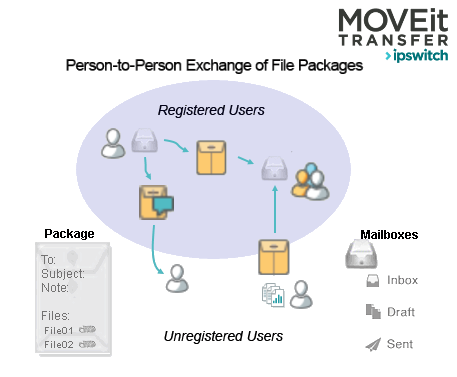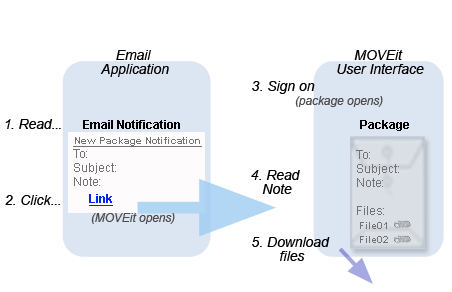Organizations can use MOVEit Transfer Ad Hoc Transfer for person to person file transfer. Registered users can send a package, which contains a message and files, similar to an email message with attachments, to other registered members, and, if enabled, to unregistered users who are handled as temporary users or per-package guest users. If enabled, unregistered users can self-register so that they can initiate the sending of packages.
MOVEit Transfer Ad Hoc Transfer: Person-to-Person Exchange of Memos, Messages, and File Attachments

Control over which users can send packages to other users is controlled through address books, which can be configured by the organization administrator. A user's address book can include registered and previously unregistered users who are now considered temporary users. Transfers to and from unregistered users is a feature of Ad Hoc Transfer only (i.e., not to File Transfer with folders).
The Address Book is a list of users and groups to whom the user may send packages. If enabled, users can also send packages to registered users not in their Address Book, and to unregistered users, in which case MOVEit creates a temporary user. Upon receiving a package from a user who is not in the recipient's address book, an entry is added in the recipient's address book so that replies are possible.
Another option lets users send packages to an unregistered user with a "package password," in which case, a temporary user is not created. A "package password' provides access to the package sent only, and can be used for a one-time, or infrequent, correspondence with recipient(s).
Groups can also have address books, and the entries in a group's address book are automatically available to the members of that group.
The Organization administrator can set options that determine who can send and receive packages. An option enables unregistered users to be recipients, and another option unregistered users to self-register and send packages. Options specify whether senders can send to additional recipients outside of their address book. If so, senders can enter a username, real name, or email address of any registered user, or the email address of any temporary or unregistered user. Other options include user- and package-level quotas, and package expiration and download limits.
Ad Hoc Transfer notifies recipients that they have received a new package. In most cases, notifications are a key part of the Ad Hoc Transfer workflow, and it is essential for the unregistered recipient workflow.
MOVEit Transfer Ad Hoc Transfer and Email Notifications

Because the content of the email notifications can aid in usability but are not secure, the administrator can set policies for how much file transfer content is included in email notifications, specifically the Note portion of the package and, to some extent, the Subject line. The administrator can set the policy for how the Note portion of packages (the message body for packages composed in Outlook) is handled. For example, should they be handled securely (sent by MOVEit only, and excluded from notification emails)? Or should they be included in the New Package Notification emails sent to recipients? After specifying the overall policy, administrators can also specify whether users get a per-package option to choose which approach to use.
Secure the Note is a package transfer-oriented approach to the message text composed by senders. An email notification is sent by the service, but it excludes the composed note. Securing the note useful if users are entering confidential and sensitive information directly into the package's note.
Turning off this option creates an email-oriented approach to the message text composed by senders. This is helpful for users who want to use the package's note to inform the recipient that they are sending the securely attached files through MOVEit and to introduce the files.
In Outlook, the note is the text the user enters in the email body when creating the package. If securing the note, that text is removed from the email that is sent as a notification email to the recipients. The text will appear only in the package after it is accessed by the recipients. Senders who look in their Outlook Sent folder will see only the notification email that was sent by email to the recipients. To see the text and the package sent, they can sign on to their MOVEit account (either in the Web UI or the Mobile App) and access their Sent (packages) mailbox.
The Subject entered in Outlook is always be used in the New Package Notification. But for the MOVEit web UI and MOVEit Mobile, whether the Subject will be used in the New Package Notification depends initially on the Secure the Note setting in the package as well as the Comment Field administrator setting.
For the web UI and mobile, the From: field in email notifications (and the Reply to: field) can be set for more or less security. (For packages sent with the Outlook plug-in, emails always are identified as from the sender.) Decide whether the From: field should show either the system's notification service or the sender's email address.